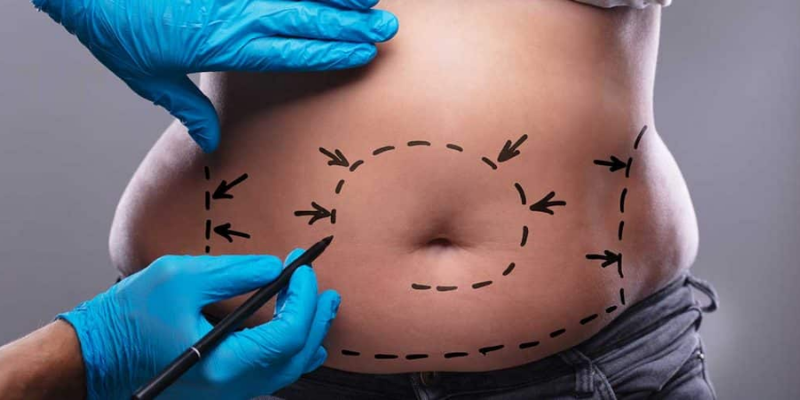Weight Loss Sleeve
While the patient is under general anesthesia, the surgeon conducts a weight loss sleeve via the sheath. The laparoscope and other surgical tools are introduced into the belly via a six-penny incision. The surgeon frequently lifts the internal organs’ skin and muscles before beginning the treatment by inflating the abdomen with gas. The surgeon separates the stomach from the fatty and connective tissue with a high-frequency scalpel and then seals the tiny blood arteries. Within three weeks, most people are able to resume their typical routines. Because it is less intrusive and produces less trauma than other bariatric operations, patients typically recover quicker.
An 11-mm-diameter tube or sheath is left after the big, arcuate portion of the stomach is removed, and the surgeon starts the longitudinal resection operation. The surgeon slices the tissue while simultaneously applying multiple rows of staples to a region using an endoscopic surgical device resembling an alligator clip. The doctor will keep doing this until the stomach has shrunk to its original size. Additionally, he or she may use clips, sutures, or fibrous glue to strengthen the incision that has been closed on the rest of the stomach after surgery. Laparoscopic gastrectomy may remove up to 85% of the stomach depending on the original size of the organ.
During the recuperation period after a laparoscopic gastrectomy, the patient is closely monitored before being brought to a room. Post-operative pain may be alleviated with the use of a pre-programmed pump, prescribed by the doctor. Most patients are up and about the day after surgery. Most patients begin a liquid protein diet the next day and continue it for the first three weeks after surgery.
Weight Loss Sleeve Process
Stomach reduction surgery is a surgical procedure, and it is often use to treat obese individuals who are unable to reduce weight with exercise and nutrition alone. Diets for those who have had stomach reduction surgery should be adhered to in accordance with their doctor’s dietary recommendations. One year is the typical recuperation time after gastric bypass surgery. After a successful recovery after stomach surgery, patients should prioritize a nutritious diet and regular physical activity. Following an assessment by a skill multidisciplinary team (bariatric surgeon, internal medicine/endocrine expert, radiology specialist, anesthesiologist, psychologist, dietician, coordination assistant..) and rigorous exams, gastric reduction surgery is conducting. Using the laparoscopic (close) surgical technique, an experience team of surgeons in an operating room specifically designing for weight-loss surgery performs the procedure after the patient is admitting to the hospital, necessary preparations make in the general surgery ward, and premedication medications have been administering.
Approximately 70-80% of the stomach’s outer layer is remove during surgery using specialize equipment and a camera picture to aid in the stomach reduction procedure. In order to limit the risk of complications, a second layer of recess stitches is adding to the incision and staple line where the reduction is finish. 24 hours following the procedure, the patient is checking for gastric or leakage issues.
Weight Loss Sleeve Procedure
The patient is able to walk or move around four hours following the procedure. Liquid feeding begins after 24 hours of control / leak control. The patient might release from the hospital on the second or third day once he or she has receive the requisite training and nutrition regimen. The patient is in frequent communication with our staff during the diet regimen. 15 days of liquid feeding; The following 15 days are in the time of feeding with puree and soft food, and after 1 month, typical calorie-adjusted nutrition within the diet list. To avoid the sense of being stranding, liquid and solid meals should not consume at the same time during this time period. A minimum of 25-30 minutes should elapse between feedings of liquids and solids.
Additionally, doctors’ follow-ups should never halting, and nutrition and psychological assistance must maintain. One, three, six, and twelve months following surgery, further checks and exams are recommending. In cases when patients are unable or unwilling to go to the hospital, they should refer to their primary care doctors. This is the only method to get the finest outcome.
Weight Loss Sleeve Review
With just millimetric holes for entry, laparoscopic sleeve gastrectomy may finish with minimum discomfort and great cosmetic results. On the 10th postoperative day of one of our instances, you can see the incision condition, which will almost unnoticeable in a few months. Our patients are able to walk immediately after surgery, go home the third day. They return to work and power in as little as six to seven days. Around the globe, laparoscopic Sleeve Gastrectomy (Tubular Stomach) surgery is one of the most popular treatments for treating obesity.
The procedure is conducting laparoscopically (close or without a knife). It reduces the anesthetic time and allows the patient to recover quicker. Sleeve Gastrectomy reduces stomach capacity. It is also a restricted approach. It is a laparoscopic operation conducting under anesthesia via tiny openings in the belly. 2/3 of the stomach is removing. The remaining stomach volume is 100-150 ml (1 tea glass). A nasogastric tube calibrates the stomach to ensure there is no stenosis or extra stomach wall.
Reducing residual stomach capacity by 2/3 decreases food intake. Moreover, the lower stomach capacity enhances satiety with less meal. Appetite is lower by eliminating stomach tissue, which secretes the Ghrelin hormone that increases hunger. The “Hunger Hormone” boosts appetite, food consumption, and fat accumulation. Obese persons have greater ghrelin levels. Those who have undergone bariatric surgery have substantially lower ghrelin levels than those who are dieting and exercising normally.
Weight Loss Sleeve Result
Gastric sleeve surgery works by shrinking the stomach. If we assess all bariatric surgery approaches, a successful and achievable aim is a 50-75 percent weight reduction. After a year, this goal is reaching. The rate of weight loss is frequently connecting to the patient’s age, gender, co-morbidities, and dietary habits. You will succeed if you can manage your recovery and adjust your lifestyle. However, owing to the small stomach capacity and variables that affect vitamin absorption, vitamin B12 and iron (Fe) supplements should take.
Can U Gain Weight After Gastric Sleeve Surgery for Weight Loss?
Whether can u gain weight after gastric sleeve’s answer is yes. It is possible to gain weight after gastric sleeve surgery for weight loss. This is because the procedure does not stop you from eating unhealthy foods or overeating. You will still be able to consume large amounts of food, but your stomach size has been reduced so you may not be able to eat as much as before. To prevent weight gain after gastric sleeve weight loss surgery, it is important to make lifestyle changes such as avoiding processed and high-calorie foods, limiting portion sizes, and exercising regularly. Additionally, monitoring your food intake and maintaining healthy eating habits can help you achieve long-term health goals such as maintaining healthy body weight.

Keeping these tips in mind can help you successfully manage any changes that may occur after the procedure and support your overall health goals. Seeing a doctor or dietitian who specializes in bariatric weight loss surgery or nutrition can also provide guidance on how best to adjust your diet in order to ensure optimal health outcomes post-surgery. You can also ask “can u gain weight after gastric sleeve?” to your doctor



